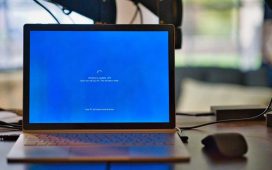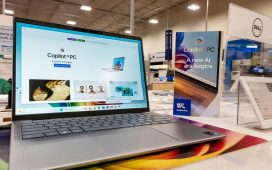
- As an executive perk and to help the company look modern as a subtle corporate marketing effort by its customer-facing sales and marketing staff. (“If you don’t want to give them a Mac, you give them a Surface,” notes IDC’s Ma.)
- As a software and web development platform, because Macs can be used to develop and test software for Windows, macOS, Linux, iOS, and Android. (Two x86 virtualization applications — Parallels Desktop and Broadcom’s VMware Fusion — let Windows and Linux run on Macs, including the newer Mac models that use Apple’s M-series chips.)
- As a creative platform, because the Mac was the first mainstream computer to support a graphical interface and so was where the mainstay image editing, illustration, and video applications first became available. Although creative services app powerhouse Adobe Systems long ago ported its apps to Windows, creative staffs stuck to using the Mac because they prefer its user interface and overall design. And some mainstay creative apps, like Apple iMovie, have no equivalent Windows counterparts.
Macs are known for being pricey — there are no $600 models to compete against Windows PCs in the broad consumer PC market. But the price differences are narrower in business cases. For business, the MacBook Pro is the premium model, and the MacBook Air is the broad-base model. They might cost a little more than the equivalent-quality Windows business laptops, but not dramatically so.
Apple’s support of business users has run hot and cold over the years, leaving many IT pros uncertain if they can get the needed support for the Macs they allow. Today, Apple has fairly strong business support, with enterprise AppleCare plans that include on-site and next-day repairs in many markets for businesses with as few as 200 Macs, support from well-known resellers like CDW, support for enterprise Apple IDs (so employees aren’t using personal ones for work), Apple-financed leasing options, and the Apple Business Manager tool for Mac enrollment and management by small businesses.
Apple has strong security in its Mac platform, especially in the M-series Macs. And for a decade, unified endpoint management (UEM) tools — even Microsoft’s Intune — have let IT manage Windows PCs, Macs, iPhones and iPads, and Android devices from a common system.
Of course, even if users prefer Macs and IT is happy to support them, there remains the reality that the application portfolio for macOS is smaller than for Windows, so your business may have apps that require the use of Windows. For example, Microsoft Access, Microsoft PowerBI, Microsoft Visio, Intuit QuickBooks Enterprise, SAS Visual Analytics, and a slew of industry-specific apps have no macOS versions.
And Mac apps may be less capable than their Windows counterpart; Microsoft Excel for Mac, for example, supports fewer advanced formulas than the Windows version, only partially supports data connections to other apps and Office’s Visual Basic for Applications (VBA), and doesn’t support at all Power Pivot or Power Chart — so data analysts, accountants, financial analysts, and CFOs often can’t use the Mac version of Excel.
The move to the cloud and thus browser-based apps has narrowed the app gap with Windows, but a gap still remains.
How to assess IT support for Linux PCs
Linux has a very small base of users, concentrated in development and engineering. But if those users must run Linux apps, you need to provide and support Linux PCs.
Of the top PC makers, Acer, Dell, HP, and Lenovo all sell Linux PCs, so IT can typically rely on the PC maker, MSP, or reseller to provide and support Linux in addition to Windows.
How to assess IT support for Chromebooks
Another niche is Google’s ChromeOS platform. Popular in some countries in elementary school use due to cheap cost (about $200), strong security, and easy management, ChromeOS’s user base largely fades away by high school and college, says Gartner’s Kleynhans. “We’re not seeing significant traction in business,” he says, especially because the $200 “cheap plastic” models used in elementary schools aren’t suited for business users. The business-class Chromebook laptops and Chromebox desktop PCs cost as much as a Windows PC, “so why get a pared-down device?” he asks.
Still, Chrome can have a place as a computing appliance. “Chrome does make sense in some frontline jobs,” Kleynhans says. IDC’s Huang cites Domino’s, where the pizza chain installed Chromeboxes in its stores so staff could easily order more supplies as needed. Chromebooks are also used on forklifts for some logistical operations, he notes. “Chromebooks can replace a thin client to make a connection between a light device and a specific use case,” he says.
The major Windows PC makers — Acer, Asus, Dell, HP, and Lenovo — all offer Chromebooks and Chromeboxes. So you can source your ChromeOS devices from the same PC makers, MSPs, or resellers as your Windows PCs — or you can choose a specialty reseller that is experienced in your specific niche use case for ChromeOS machines.
How to assess IT support for iPads
Another niche computing device is Apple’s iPad. Whether it is a computer has long been a debate, even though it can run some standard business apps like Microsoft Office and most cloud-based tools via the Safari browser. Apple has also adopted computer-like functions such as split screen for side-by-side application use and support for physical keyboards, pens, and trackpads.
When the Pad first debuted in January 2010, it was significantly lighter and smaller than the laptops of the era, so the iPad was attractive for field use as well as for knowledge-worker computing while on the road. But since then, the 2-in-1s and thin laptops have edged out the iPad for many such uses, says Forrester’s Hewitt.
Some firms do issue iPads as specialty computers for specific applications, especially around field work. United Airlines, for example, issues iPads to its aircraft maintenance workers because of their light weight and because workers can quickly and easily authenticate themselves at the job site via Touch ID, rather than signing into a bulkier laptop via a password while working in an airplane. They also eliminate the extra steps of taking paper notes and re-entering them on a computer back at the office. iPads are also commonly used as single-purpose registration devices at conferences and hotels in what Apple calls kiosk mode.
For most users, though, “the iPad is a companion device” used for light work such as email, presentations, and web access at conferences, in sales demos, or in business meetings, Hewitt says. Often, they are not corporate-issued but instead corporate-managed in a bring-your-own-device (BYOD) model.
Support and service considerations in choosing a PC supplier
When IT buys PCs, it usually wants the vendor — whether a PC maker, reseller, or MSP — to do much more, often including the logistics of PC setup, enrollment, and deployment; of monitoring and handling upgrade cycles; of decommissioning, data sanitization (removing all corporate information), and takeback or recycling at end of life; and of managing urgent replacement of damaged, lost, or stolen laptops. These “basic life-cycle services are fairly vendor-agnostic,” notes Gartner’s Kleynhans.
A purchase contract plus a separate management contract is the typical arrangement. But IT may also want the PC supplier or other entity to manage user support, repairs, and laptop health (such as monitoring security software, antivirus findings, password aging, application and operating system updates, and use of unauthorized applications). That can involve a separate contract with the same PC provider or with a separate provider, or be combined with the basic life-cycle services contract as an essentially full outsourcing arrangement.
IT will see more differences among PC makers, resellers, and MSPs in the offerings for these additional service areas, so be prepared to dig into what each candidate supplier can offer and at what price and service level.
Forrester’s Hewitt notes that the odds are 50-50 that a given reseller for medium and large enterprises can also provide support, repair, and maintenance services. Very few small business-oriented resellers can do more than supply the PC, he says, so you’ll likely need to handle the rest of the services yourself or, for repairs, through a warranty program.
IT also needs to decide if it wants to split these services based on platform and/or geography, in areas where Kleynhans says there are “natural divisions” in the organization. Those divisions are more likely in large, geographically disperse enterprises.
For example, IT may want to separate its Mac fleet from its PC fleet across all service operations so deeper, more specific expertise is assigned to each. Or IT may want to have separate providers for various regions if no single vendor has the appropriate reach, or if it makes more business sense to keep local reseller arrangements in place in some markets. (“Why force Australia to change vendors?” he asks, if there’s no compelling case to force the business entity there to use the same provider as in the US or Europe.)
Still, “for most organizations it is best to focus on a single large supplier as primary and have a qualified secondary vendor for special use cases,” Kleynhans says. “It’s typical to have a reseller and direct mix,” adds IDC’s Ma.
Financial considerations in choosing a PC supplier
Although IT doesn’t drive the financial approach, it has to work with that approach. Some companies prefer to treat equipment purchases as capital expenses (capex), while others prefer to treat them as operational expenses (opex). The first approach means an actual purchase of the equipment, where the organization owns the PCs and incurs the expense all at once. The second approach essentially means a lease or subscription, where ownership remains with the supplier and the costs are spread out over the lease or subscription term.
That term-based approach for opex also means IT has to determine how long to have PCs in service before they are replaced in the lease or subscription. Three years is a typical term, and four years is usually an option.
But some PCs perform well — and show little wear and tear — for five or six years, while others get terribly banged up in a couple years (such as those used by traveling salespeople) or are workstation-class PCs used for very high-performance applications like video rendering and visual analysis where faster hardware is typically needed sooner than for standard business and web applications. IT needs to make sure that the lifespan in the contract satisfies its typical reality — replacing PCs every three years when they routinely last for four years is just a waste of money — and that the contract addresses what to do about outlier periods. Forrester’s Hewitt notes that some PC providers offer opt-out clauses that let you keep PCs longer than contracted — for a price, of course.
Under the capex approach, IT can be more flexible about replacing PCs, doing so on a case-by-case basis, such as replacing PCs only when significant compatibility issues arise, where they are in poor physical shape, or where performance has degraded meaningfully, or by using an exception-based approach in which PCs are replaced on a regular schedule unless there are extenuating circumstances. The capex approach also lets IT stretch out the purchase cycle when money is tight or replace PCs sooner if significant new useful capabilities come to market and funds are available.
PC makers, larger resellers, and MSPs typically support both the capex and opex approaches, though smaller resellers may only support capex’s outright purchase.
For enterprises that prefer the opex approach, there’s rising interest in the subscription model, typically called “device as a service” or “DaaS” (and “PC as a service” or “PCaaS” by Dell). Be careful with the term, though: The DaaS acronym also means the wholly different desktop-as-a-service type of thin client, described in a previous section, and the word “device” often means other office equipment, not just PCs. In fact, the device-as-a-service model for PCs originated in 2014 with HP, which had previously shifted its enterprise printer business to a subscription approach and then saw an opportunity to do so for PCs, says IDC’s Huang.
A device-as-a-service subscription differs from a lease in that a subscription is to ensure employees have a PC over the long term, with the individual PCs getting replaced as they reach end of life — you’re paying to ensure your employees have an appropriate PC to use at any time, not a specific PC as of a certain date. By contrast, in a lease you’re renting a specific PC for a specific period, after which you return it to the PC provider or buy it for its residual value — just like how car leases work. Also, with a subscription, you’re buying operational services for the PCs and their users, not just the PCs themselves, whereas a lease separates the PC purchase from any other services that might be contracted.
Although the subscription model has gained a lot of IT interest in recent years, actual enterprise adoption is quite low, in single-digit percentages, agree all four analysts interviewed for this article. “The use cases and customer stories are slim pickings,” says Forrester’s Hewitt. The major reasons are that most enterprises prefer the capex model because they can scale purchases up or down to better handle cash flow, they can have an inventory of replacement units they directly own in hand for emergencies, and they believe they have more control because the PCs are contractually separate from other services purchased.
Environmental considerations in choosing a PC supplier
Climate change and sustainability have made environmental considerations a factor in many business decisions, including equipment used. This falls under the banner of environmental, social, and governance (ESG), and most large enterprises have ESG requirements that IT must follow. IDC’s Huang says that environmental considerations will only gain more importance in the coming years because Gen Zers care very much about the environment. “Gen Z is starting to trickle into management, and they are influencing environmental factors. That’s where the puck is going,” he says.
For IT in organizations of all sizes, the good news is that ESG compliance has largely become a checkbox item when purchasing PCs, says IDC’s Ma, because PC makers have already changed their supply-chain, manufacturing, and packaging processes to reduce waste, reduce energy usage, increase recycling, and reduce or eliminate the use of toxic materials. “It’s table stakes,” he says. “All the vendors are doing good work,” echoes IDC’s Huang.
Still, some PC makers are more environmentally forward than others. For example, Apple years ago switched to aluminum chassis, which are highly recyclable and aren’t derived from fossil fuels like plastic ones are. And Asus offers PC models that have high percentages of postconsumer recycled plastic to reduce the use of fossil fuels.
There’s less attention to what happens after a PC is manufactured and deployed, Huang says. Apple’s recycling program for consumers is widely known because it has the visibility of its Apple Stores and online store taking back old devices and sometimes providing a purchase credit, but Apple is by no means alone in recycling old devices or refurbishing them for resale: Recycling of old PCs is available from all the major PC makers. However, to what extent that IT takes advantage of those recycling programs is unclear, Huang says.
Another often overlooked environmental issue is what to do with batteries that lose charge capacity, making otherwise serviceable laptops unusable. All major PC makers have programs to replace worn-out batteries in their laptops, even those like Apple whose batteries cannot be replaced directly by IT or users.
Finally, the best way to conserve resources is to not use them. Keeping PCs longer means fewer new ones need to be built and fewer old ones need to recycled, refurbished, or trashed. Given that business-class PCs typically are well constructed, lengthening the standard three-year replacement cycle is one of the easiest environmental steps IT can take — and it saves on hardware costs, too.
Geographic considerations in choosing a PC supplier
Finally, where your workers are can be a huge factor in your PC supplier decisions. If you operate in multiple countries, you need to make sure your PC suppliers and the related support organizations can service those locations well. That means having local inventories for fast deployment and local repair operations, and being able to provide support in the employees’ native languages. A multinational PC provider might be able to support such geodiversity, but chances are that you’ll need to supplement a primary provider with local ones, says Forrester’s Hewitt. At the end of the day, “you need the right sales channels and support channels,” adds IDC’s Ma.
Geography is less a factor in the specific brand of PC used, says Gartner’s Kleynhans. “The big three are similarly matched across the globe,” he says. But there are some regional differences: Dell, HP, and Lenovo all sell less well in Africa than elsewhere, a gap that Acer has partially filled. China-based Lenovo tends to sell better in China and other Asian countries, whereas US-based Dell and HP tend to sell better in North America.
In addition to Africa, Acer sells well in Taiwan (its home country) and in India, where it long has been the choice of the public sector, which opened doors in commercial firms as well, says IDC’s Ma. Microsoft’s Surface line has a solid presence in North America, Europe, and Australia, says Gartner’s Kleynhans.
And, as previously noted, Apple does well in several developed countries — mainly in North America and Europe, but it has outposts in South America and Asia — where it has outsized market share in the consumer space. (Countries where Apple Business Manager is offered provide solid insight into where IT can expect good sourcing and support options.)
Finding a reseller
There are several ways to find a reseller in your region.
Chances are that a midsize or large organization already has an incumbent reseller. If you seek a reseller for a new division with specialized computer needs or for a new geographic location, Kleynhans suggests you first ask that existing reseller to recommend partners.
Whether to get a new reseller, replace one, or add one where your current reseller can’t provide what you need, midsize and large enterprises likely have potential reseller candidates on file from ongoing sales inquiries by resellers hoping to get your business. “Most of the resellers are pretty aggressive with outbound sales,” Kleynhans says.
PC makers can provide reseller recommendations, says IDC analyst Bryan Ma. Contact the PC maker’s sales rep for your region to get suggestions. PC makers also have online directories of resellers that help you find resellers in your local area; these are typically small resellers that serve smaller businesses with basic services such as purchasing, warranty management, and takeback. Reseller directories are provided by:
- Acer: The acer.com website automatically defaults to your region’s local site, but you can switch regions by clicking the globe icon in the far right of the header. In the footer, go to the Resources section and click the Where to Buy link (or its equivalent in the chosen language.
- Apple provides listings of business-oriented resellers globally — with pages for the Asia-Pacific region; Europe, the Middle East, and Africa; and Canada, Latin America, and the United States — as well as a directory of Apple Stores for small businesses.
- Asus: The asus.com website automatically defaults to your region’s local site, but you can switch regions by clicking the globe icon at the far right of the footer. There’s no standard design for the various regional sites, so it can be hard to find resellers. Look for the Where to Buy link in the footer or, when there is no Where to Buy link, for links on the home page to laptop or other relevant shopping pages.
- Dell: The dell.com website requires that you first pick the desired region using the globe menu at the far right of the header on many pages, then at the page footer choose Find a Reseller or Find a Partner (or equivalent text in the chosen language), depending on Dell’s business setup. You may get redirected to delltechnologies.com in some cases.
- HP provides a global directory page whose location you can specify.
- Lenovo provides a global directory page whose location you can specify.
In some parts of the world, media organizations publish guides to local resellers. For example, Germany’s ChannelPartner (published by IDG’s Foundry, which also publishes Computerworld) has a reseller directory for the German market as well as a directory of German online PC sellers.
However you find your reseller candidates, Gartner’s Kleynhans says, “What can be difficult is understanding who might match your needs. The typical approach is to run an RFI [request for information] with several candidates seeing what they offer against a set of needs you might have.” An RFI isn’t as complex or burdensome to either IT or the reseller as an RFP (request for proposal), he notes, but “is a first step in creating a short list if you don’t already have one.” The RFI responses will then help narrow which resellers you would ask to engage in a more detailed RFP process.
Read this next: Buyer’s guide: How to choose the right business laptops











